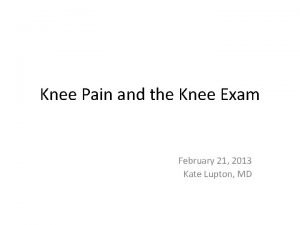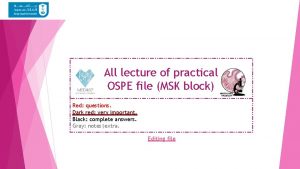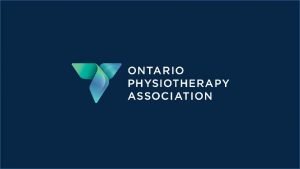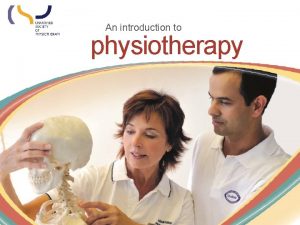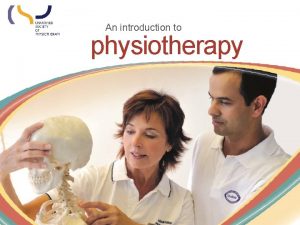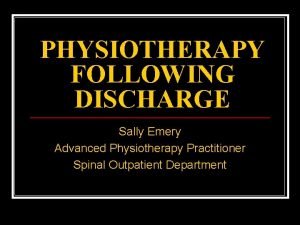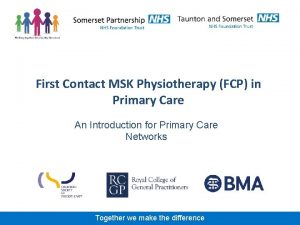Innovating Care Pathways Advanced MSK Physiotherapy Practitioners Emergency












- Slides: 12

Innovating Care Pathways Advanced MSK Physiotherapy Practitioners (Emergency Care) Bekki Seal Trainee Consultant Physiotherapist in Emergency Care Portsmouth Hospitals NHS Trust Twitter: @Bekki. Seal

Background MSK Physiotherapist by background across a variety of settings Emergency Practitioner Role Trainee Consultant Physiotherapy Practitioner in Emergency Care (Health Education England Wessex) ED Physio Aims: o Early diagnosis accurate prognosis, appropriate and timely treatment options for patients with musculoskeletal disorders o Patient education and self-management o Collaborative working across the interfaces of ED/Orthopaedic/Primary Care

The Problem NHS crisis Increasing demands system wide Ageing population Workforce crisis - Particularly within Emergency and primary care (ED and GP) (White, 2014; Hallows, 2016) Fragmented care models (Department of Health, 2001) MSK burden - a big part of the problem (Clark & Ellis, 2014; Parsons & Symmons, 2014)

MSK Pathway Patient Ortho Surgery GP ED Ortho Fracture Clinic X-ray Physio Podiatry Psych Pain Clinic Injection Ortho Elective Clinic MRI Rheum

The Patient Time Searching Diagnosis Uncertainty regarding prognosis Work Home Independence (Clark & Ellis, 2014; Parsons & Symmons, 2014)

Advanced Physios A Part of The Solution? Could advanced MSK physiotherapists working across the MSK pathway be a part of the solution? Physios are trained to see, clinically reason, differentially diagnose and manage patients presenting with MSK conditions Trained to identify those with associated serious pathology (medical masquerades) Key role – patient education, self management, prevention, exercise, well being and quality of life ED challenges and advancing practice: New environment – different presentations, some additional training required. (Farrell 2014; Kilner et. al 2011; ; Lebec & Jogodka 2009; Morris, Vine & Grimmer, 2015)

RCEM president meeting Possibilities of the role Additional skillset for the team (ENP, medics) Curriculum requirements (Typical practitioner versus additional requirements for an experienced physio). Advanced components: IRMER/X-ray interpretation and possibly prescribing are key to success.

Significance of the role - Physio Perspective MSc study ‘A phenomenographic approach exploring the significance of the advanced MSK physiotherapy role in the ED from the perspective of physiotherapists in post’ Senior MSK decision-makers Additional skillset Patient care: Increasing quality of acute MSK care provision Patient pathways – appropriate and timely Collaborative working across the interface, dual roles Curriculum and governance

Barriers and Drivers Local trusts – operational and strategic drivers Conversations with stake holders Commissioners, complexities of MSK systems Governance Research – difficult to remunerate TCP programme has allowed an early exploration of this topic. now excited to be embarking new journey to explore this topic I am on a (PHD).

Thank you Any Questions?

References Anaf, S. , & Sheppard, L. A. (2007). Physiotherapy as a clinical service in emergency departments: a narrative review. Physiotherapy, 93(4), 243 -252. doi: 10. 1016/j. physio. 2007. 04. 006 Clark, P. , & Ellis, B. (2014). A public health approach to musculoskeletal health. Best Practice & Research in Clinical Rheumatology, 28(3), 517 -532. doi: 10. 1016/j. berh. 2014. 10. 002 Desmeules, F. , Roy, J. , Mac. Dermid, J. C. , Champagne, F. , Hinse, O. , & Woodhouse, L. J. (2012). Advanced practice physiotherapy in patients with musculoskeletal disorders: A systematic review. BMC Musculoskeletal Disorders, 13(1), 107. doi: 10. 1186/1471 -2474 -13 -107 Department of Health. (2001). Reforming emergency care: First steps to a new approach. (). London: Department of Health. Retrieved 04. 06. 16 fromhttp: //webarchive. nationalarchives. gov. uk/20130107105354/http: /www. dh. gov. uk/prod_consum_dh/groups/dh_digitalassets/@dh/@en/documents/di gitalasset/dh_4058836. pdf Farrell, S. F. (2014). Can physiotherapists contribute to care in the emergency department? The Australasian Medical Journal, 7(7), 315. Guengerich, M. , Brock, K. , Cotton, S. , & Mancuso, S. (2013). Emergency department primary contact physiotherapists improve patient flow for musculoskeletal patients. International Journal of Therapy and Rehabilitation, 20(8), 396 -402. doi: 10. 12968/ijtr. 2013. 20. 8. 396 Hallows, N. (2016, March 10) GPs near breaking point. BMA Press Release. Retrieved 05. 08. 16 from https: //www. bma. org. uk/news/2016/march/gpsnear-breaking-point Jibuike, O. O. , Paul-Taylor, G. , Maulvi, S. , Richmond, P. , & Fairclough, J. (2003). Management of soft tissue knee injuries in an accident and emergency department: the effect of the introduction of a physiotherapy practitioner. Emergency medicine journal : EMJ, 20(1), 37 -39. doi: 10. 1136/emj. 20. 1. 37 Kempson, S. M. (1996). Physiotherapy in an accident and emergency department. Accident & Emergency Nursing, 4(4), 198 -202. doi: 10. 1016/S 09652302(96)90081 -8

References Kilner, E. (2011). What evidence is there that a physiotherapy service in the emergency department improves health outcomes? A systematic review. Journal of health services research & policy, 16(1), 51. Lebec, M. T. , & Jogodka, C. E. (2009). The physical therapist as a musculoskeletal specialist in the emergency department. The Journal of orthopaedic and sports physical therapy, 39(3), 221. doi: 10. 2519/jospt. 2009. 2857 Mock, C. , & Cherian, M. N. (2008). The Global Burden of Musculoskeletal Injuries: Challenges and Solutions. Clinical Orthopaedics and Related Research, 466(10), 2306– 2316. http: //doi. org. ezproxy. brighton. ac. uk/10. 1007/s 11999 -008 -0416 -z Morris, C. D. , & Hawes, S. J. (1996). The value of accident and emergency based physiotherapy services. Journal of accident & emergency medicine, 13(2), 111 -113. Morris, J. , Vine, K. , & Grimmer, K. (2015). Evaluation of performance quality of an advanced scope physiotherapy role in a hospital emergency department. Patient Related Outcome Measures, 6, 191. Parsons, S. , & Symmons, D. P. M. (2014). The burden of musculoskeletal conditions. Medicine, 42(4), 190 -192. doi: 10. 1016/j. mpmed. 2014. 01. 009 Richardson, B. , Shepstone, L. , Poland, F. , Mugford, M. , Finlayson, B. , & Clemence, N. (2005). Randomised controlled trial and cost consequences study comparing initial physiotherapy assessment and management with routine practice for selected patients in an accident and emergency department of an acute hospital. Emergency Medicine Journal, 22(2), 87 -92. doi: 10. 1136/emj. 2003. 012294 Taylor, N. F. , Norman, E. , Roddy, L. , Tang, C. , Pagram, A. , & Hearn, K. (2011). Primary contact physiotherapy in emergency departments can reduce length of stay for patients with peripheral musculoskeletal injuries compared with secondary contact physiotherapy: a prospective non-randomised controlled trial. Physiotherapy, 97(2), 107 -114. doi: 10. 1016/j. physio. 2010. 08. 011 White, C. (2014, Dec 23 rd) Almost one in four Emergency Medicine Trainees plan to leave UK or leave speciality. BMJ Careers. Retrieved 04. 08. 16 fromhttp: //careers. bmj. com/careers/advice/Almost_one_in_four_emergency_medicine_trainees_plans_to_leave_UK_or_leave_specialty







